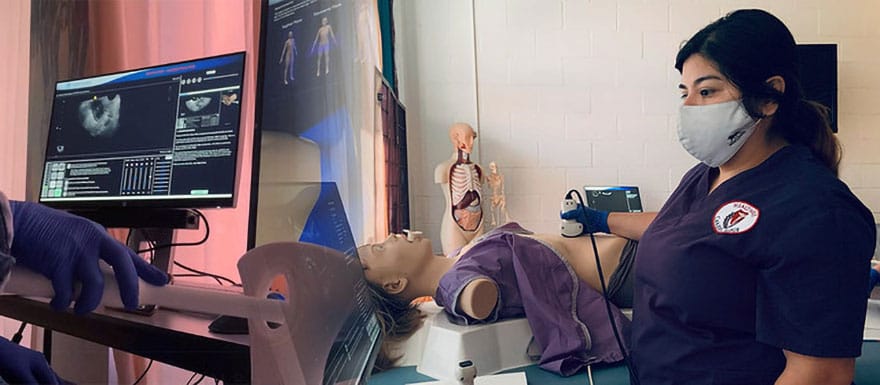Ultrasound Technician Certification

Everything You Need to Know About Ultrasound Technician Certification in California
Ultrasound Technicians use ultrasound machines to scan patients for abnormalities and take images of normal and diseased structures which are then sent to the physician to help diagnose the patient. Ultrasound Technicians not only scan expectant mothers, but other anatomical structures such as; abdominal organs, breast, and musculoskeletal structures just to name a few.
Ultrasound Technicians are encouraged to sit for two state board examinations; the physics portion and a specialty examination. There are conditions and limitations that will change the pathway a student is required to follow depending on the type of school a student attends which we will go over in this article. Continue reading to find out everything you need to know about Ultrasound Technician certification in California and how to become an ultrasound technician.
What Prerequisites Do You Need to Sit for Your State Board Examinations in California?
In the state of California and according to ARDMS (The American Registry for Diagnostic Medical Sonography) website, to be eligible to sit for a state board exam, students must attend a Diagnostic Medical Sonography program at minimum. Diagnostic Medical Sonography programs range in length, typically taking around two to four years to complete.
There are two parts to becoming an Ultrasound Technician, first is to sit for the SPI (Sonography Principles and Instrumentation) exam after completing a physics course with a grade C or higher. A physics course is typically included in a Diagnostic Medical Sonography program and will be an essential class that every Ultrasound Technician is required to take prior to sitting for their specialty exam.
STEP 1: Pass the SPI (Sonography Principles & Instrumentation) Examination
- Sitting for the SPI examination needs to be completed during or after a completing a two-to-four-year DMS program and prior to sitting for any specialty state board exams. Once obtaining the SPI credential, students are required to take a specialty exam within five years or they will need to take the SPI exam again.
ARDMS (The American Registry for Diagnostic Medical Sonography)
As mentioned, there are some conditions and limitations that follow depending on the school. CAAHEP (Commission on Accreditation of Allied Health Education Programs) accreditation allows Ultrasound Technician students who have completed a Diagnostic Medical Sonography program to sit for their specialty exam after graduation.
In comparison, a school that is not CAAHEP accredited, will require students who have completed a Diagnostic Medical Sonography program to work as an Ultrasound Technician with pay for a total of 12-months before they are eligible to sit for their specialty exam. There are a few options students have depending on the school they chose to attend such as;
Complete a Non-CAAHEP Accredited Diagnostic Medical Sonography Program
- A Diagnostic Medical Sonography program where students can sit and pass their SPI exam and receive a Certification/Diploma/Associates Degree. Obtain employment as an Ultrasound Technician with pay for a total of 12 months to be eligible to sit for a specialty exam through ARDMS.
Complete a CAAHEP Accredited Diagnostic Medical Sonography Program
- A Diagnostic Medical Sonography program where students can sit and pass their SPI exam and receive a Certification/Diploma/Associates/Bachelor’s Degree and sit for their specialty exam through ARDMS right after graduation.
Have or obtain a Bachelor’s Degree in Any Major
- Students can either have previous work history as an Ultrasound Technician for a minimum of 12-months or attend an accredited or non-accredited Diagnostic Medical Sonography program and sit for their specialty exam through ARDMS right after graduation.
ARRT (The American Registry of Radiologic Technologists)
Through recent years, ARRT started offering Diagnostic Medical Sonography credentialing. Their examination consists of both physics and specialty exam questions. This is another option for students who may be attending a non-accredited Diagnostic Medical Sonography program that would like to sit for a specialty exam right after graduation. The only catch to this option is students are required to complete an Associate’s Degree DMS program, rather than a certificate awarding Ultrasound Technician Program.
Although ARDMS is commonly the standard among the Ultrasound Technician community, ARRT is acceptable and sometimes enough to build a rewarding career as an Ultrasound Technician. It is encouraged that students who obtain credentials through ARRT, pursue further credentialling through ARDMS as well. After completing an ARRT approved DMS program, students have three years to obtain their credentials.
Complete a Two-Year Non-Accredited Associates Degree Diagnostic Medical Sonography Program
- A non-accredited Associates Degree Diagnostic Medical Sonography program where students can sit and pass their SPI exam and receive an Associate’s Degree and sit for their specialty exam through ARRT. Obtain 12-months of Ultrasound Technician work history where you will be eligible to sit for the ARDMS specialty exam.
Which Specialty Exams Can Students Sit for Through ARDMS?
ARDMS offers the following specialties, but not limited to;
- Abdomen (AB)
- Breast (BR)
- Fetal Echocardiography (FE)
- Obstetrics & Gynecology (OB/GYN)
- Pediatric Sonography (PS)
Which Specialty Exams Can Students Sit for Through ARRT?
ARRT offers the following specialties, but not limited to;
- Breast (BR)
- Vascular (VS)
How to Maintain Your Ultrasound Technician Credentials?
Maintaining credentials ensures an Ultrasound Technician is up-to-date with their education and clinical skills. A career in the medical field requires lifelong professional development which happens by continuously learning new technologies and skills.
An Ultrasound Technician that continues to grow throughout their career can provide the highest degree of patient care as well as eventually achieve career advancement. It is encouraged that all medical professionals comply with local state regulations and policies in order to maintain their credentials in a timely manner to prevent possible interruption or expiration of credentials.
Maintaining ARDMS Credentials
According to the ARDMS official website, ARDMS requires four components which will allow an Ultrasound Technician to maintain their credentials;
- An annual renewal fee paid before December 31st
- Attest to ARDMS rules and compliance policies annually
- Earn the minimum number of CMEs or Continuing Medical Education during your three-year period
- Recertification which is currently unavailable according to the ARDMS official website
Maintaining ARRT Credentials
According to the ARRT official website, to maintain an Ultrasound Technician credential, one must remain compliant with ARRT rules and regulations and ARRT standards of ethics which you can learn more about on the ARRT website. Additionally, ARRT requires Ultrasound Technicians to;
- Pay an annual renewal fee which is the last day of your birth month
- Be current with your biennial CEs or Continuing Education requirements every two-years
- Complete ARRT’s CQR or Continuing Qualifications Requirements every ten years
Want to Learn More About Ultrasound Technician Certification in California?
If you would like to learn more about Ultrasound Technician Certification in the state of California such as; prerequisites you may need, ARDMS and ARRT exams, and maintaining credentials then visit www.ardms.org or www.arrt.org for more information. If you are interested in a career as an Ultrasound Technician visit healthcarecareercollege.edu and speak with an admissions in ultrasound tech school representative to get started today!
Is a Rewarding Career as an Ultrasound Technician Right for You? Get More Info…
If you’re interested in learning more about careers as an Ultrasound Technician and exploring whether Healthcare Career College is right for you, fill out the form on this page to receive more information.
Frequently Asked Questions
How do I become an Ultrasound Technician in California?
Graduate high school, attend an accredited ultrasound tech school in California, complete the program, gain clinical experience, and obtain certification if required.
What does an Ultrasound Tech School in California cover?
Ultrasound tech schools cover anatomy, medical terminology, ultrasound principles, imaging techniques, patient care, and hands-on training.
How long does it take to become a certified Ultrasound Technician?
It takes 1-2 years to complete the program, plus additional time to prepare for the certification exam.
What are the career prospects for Ultrasound Technicians in California?
Due to increasing demand, California offers excellent career opportunities in hospitals, clinics, and medical centers.
Are there specialized certifications for Ultrasound Technicians?
Yes, specialties like abdominal, obstetric, gynecologic, vascular, and echocardiography can be pursued after certification.
For immediate questions, call (562) 804-1239


